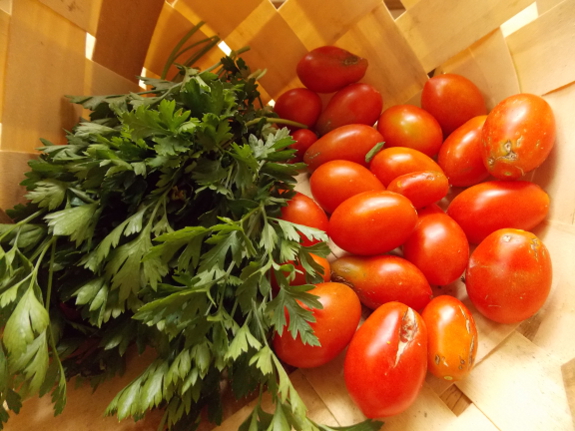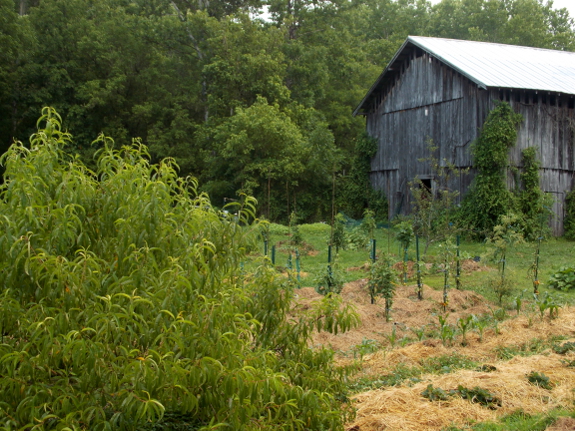
New blight-resistant tomatoes

It looks like this will be another low-tomato year, with septoria leaf spot rushing through our planting despite weekly pruning
sessions. I've also seen a couple of patches of early blight, but
the septoria is doing the majority of the damage because of its early
start.
Septoria leaf spot is
supposed to only hit tomato plants relatively late in the year, which
suggests that the fault is my own --- I probably carried the fungus over
from last year's garden in my saved seeds. In other words, any
seeds I save this year will be equally suspect, although a
heat-treatment of 25 minutes at 122 degrees Fahrenheit might possibly
make them safer to use.
Luckily, tomato breeders
are finally starting to come up with varieties that resist early blight,
late blight, and septoria leaf spot. Johnny's Select Seeds sells Jasper, a red cherry tomato with intermediate resistance to early blight and septoria leaf spot, while their Plum Regal, Defiant, and Mountain Magic are moderately resistant to late blight and early blight.
An even more enticing selection comes from High Mowing Organic. Iron Lady
is a red slicer bred by Cornell University and North Carolina State
University to resist early blight, late blight, and septoria leaf spot,
along with verticillium and fusarium wilts. I'm thinking we might
try all five resistant varieties next year and not use any of our saved
seeds in hope of getting the various tomato blights off our farm.

What's the next line of
defense if that fails? The real reason we lose so many tomatoes to
blight is because our climate is very damp, even during the
summer. We already save the sunniest spots for tomatoes and don't
use overhead irrigation there, plus we tie the plants up and prune away
leaves close to the ground. And this year I even tried raising the
plants up on mounds to produce even drier conditions, but clearly none
of that is enough to beat blight.
The next step would be blocking rain from hitting our tomatoes with a
greenhouse, hoophouse, or something similar. Or we could follow
the recommendation of a Canadian website, which suggests growing
tomatoes on a balcony or rooftop for a similar reason. One of
these days, I'll figure out how to have copious tomatoes despite our wet
climate!
Want more in-depth information? Browse through our books.
Or explore more posts by date or by subject.
About us: Anna Hess and Mark Hamilton spent over a decade living self-sufficiently in the mountains of Virginia before moving north to start over from scratch in the foothills of Ohio. They've experimented with permaculture, no-till gardening, trailersteading, home-based microbusinesses and much more, writing about their adventures in both blogs and books.
Want to be notified when new comments are posted on this page? Click on the RSS button after you add a comment to subscribe to the comment feed, or simply check the box beside "email replies to me" while writing your comment.

Not sure which I have (will send a photo--it's the little dark one with a red bottom when ripe, that I brought over, Anna)--seems to be blight resistant, not sure why, tho where it is might have a bearing, between the sage and asparagus...
I guess volunteers from the compost are also blight carriers?
@Maggie Turner: Do you perhaps mean aqueous ozone? (which is just a fancy name for an ozone solution in water).
I will readily agree that ozone is an excellent antiseptic and very suitable for e.g. sterilizing medical equipment. It is reckoned to be more effective than hydrogen peroxide and chlorine, as you can e.g. see in this paper. The reason for that is that oxygen radicals are extremely reactive. Especially with organic materials (like e.g. us!) It is actually toxic to humans. From the Wikipedia page on ozone;
In short, the reason that it works so well is not because it is benign, but because it is actually more corrosive than chloride!
However, ozone is not stable and has to be made on-site. In pure water, half of a 10 ppm solution of ozone in water will be gone in five minutes and it will be completely gone in 30 minutes. Unless the ozone reacts with something organic, it will revert to stable oxygen (O₂).
If you're going to use an ozone generator, best do it outside.
Heirlooms can be grafted to blight resistant rootstock, at least that's my plan for next year. "Matt's wild cherry" has always been very blight resistant for me as well.
Chris --- Matt's wild cherry definitely keeps popping up on the internet as the most blight-resistant heirloom. I've never tried it, but should probably add it to my trial list.
I'm less keen on the idea of grafting onto resistant rootstock. My understanding is that the rootstock only resists root-borne illnesses, and since blight tends to colonize leaves, I don't think there'd be any effect. But I'll be curious to hear your report if you give it a try.
I got a used hoop-house from a friend this spring, and I have to say I never want to go back to open air tomatoes. I tried high hoops before, with about 4 feet of space at the bottom, and just a plastic roof. It was OK, but the crows still got in and destroyed most of the crop. But this greenhouse is awesome! I got red slicing tomatoes in mid June! And cherries by mid-May! And as of yet no signs of the blight which always wiped out my crops by the end of July. And my passionfruits are finally bearing fruit! Definitely get a greenhouse!
Reading, and then thinking on the water/blight issues, I wonder if you might get yourself some creole tomato seeds. They were bred, here, by LSU, and NOLA and surrounding areas (LA Gulf Coast) are --wet--.
Worth a shot, at the least.
I will be trying Jasper this year.
One tomato I can recommend for fairly decent resistance against Septoria leaf spot is Park's Whopper. Not an exceptional flavor like heirlooms, but good and a reliable cropper for me. My grandparents over-gardened their plot and didn't rotate enough so, in VA in humid wet summers, the tomatoes would get DESTROYED by blights. Park's Whopper consistently did much better than heirlooms or other commonly available hybrids.